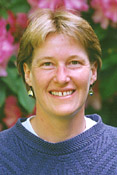Contributor Biographies
Patricia McManus has a B.S. in Botany from the University of Wisconsin-Madison, and received her M.S. and Ph.D. degrees in Botany and Plant Pathology from Michigan State University.  The Ph.D. thesis, done in the lab of Alan Jones, was Ecological and genetic analysis of streptomycin-resistant Erwinia amylovora in Michigan and epidemiology of fire blight in an apple nursery. Patricia's current position since 1995 is Assistant Professor in the Department of Plant Pathology at the University of Wisconsin-Madison. Her responsibilities are divided at 75% extension and 25% research. Current interests include etiology and integrated management of diseases of fruit crops important to the economy of Wisconsin, especially cranberry and apple; strategies to reduce the risk and delay the onset of pesticide resistance; antibiotic resistance in plant-associated bacteria, especially streptomycin resistance in Erwinia amylovora; and sustainable apple production.
The Ph.D. thesis, done in the lab of Alan Jones, was Ecological and genetic analysis of streptomycin-resistant Erwinia amylovora in Michigan and epidemiology of fire blight in an apple nursery. Patricia's current position since 1995 is Assistant Professor in the Department of Plant Pathology at the University of Wisconsin-Madison. Her responsibilities are divided at 75% extension and 25% research. Current interests include etiology and integrated management of diseases of fruit crops important to the economy of Wisconsin, especially cranberry and apple; strategies to reduce the risk and delay the onset of pesticide resistance; antibiotic resistance in plant-associated bacteria, especially streptomycin resistance in Erwinia amylovora; and sustainable apple production.
Virginia Stockwell graduated from Rutgers University with a B.A in Biology and received her Ph.D. in Botany and Plant Pathology from Colorado State University in 1984.  She worked as a postdoctoral scientist with the USDA, Agricultural Research Service and Oregon State University on Tilletia controversa, the fungus that causes dwarf bunt of wheat, and on biological control of crown gall, caused by Agrobacterium tumefaciens. She began working on biological control of fire blight of pear and apple, caused by Erwinia amylovora, in 1990. In 1999, she was appointed as an Assistant Professor of Research in the Department of Botany and Plant Pathology at Oregon State University. Her research focuses on integrated management of bacterial diseases with an emphasis in biological control, mechanisms of biological control, microbial ecology of deciduous fruit blossoms, and the development of resistance of bacterial pathogens to antibiotics used in agriculture. Currently, she is the chair of the APS Biological control committee and a member of the Phyllosphere microbiology committee.
She worked as a postdoctoral scientist with the USDA, Agricultural Research Service and Oregon State University on Tilletia controversa, the fungus that causes dwarf bunt of wheat, and on biological control of crown gall, caused by Agrobacterium tumefaciens. She began working on biological control of fire blight of pear and apple, caused by Erwinia amylovora, in 1990. In 1999, she was appointed as an Assistant Professor of Research in the Department of Botany and Plant Pathology at Oregon State University. Her research focuses on integrated management of bacterial diseases with an emphasis in biological control, mechanisms of biological control, microbial ecology of deciduous fruit blossoms, and the development of resistance of bacterial pathogens to antibiotics used in agriculture. Currently, she is the chair of the APS Biological control committee and a member of the Phyllosphere microbiology committee.
RETURN TO APSnet FEATURE STORY
